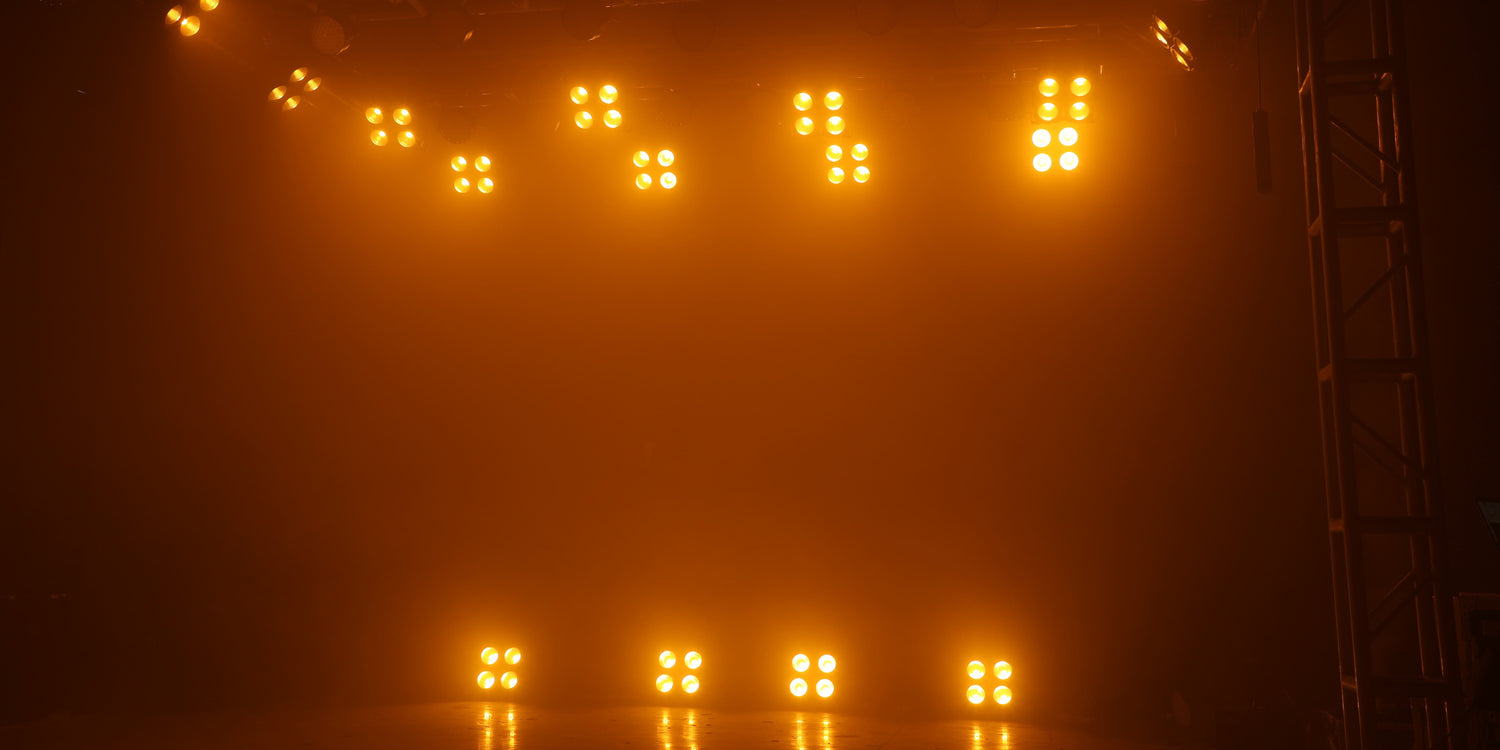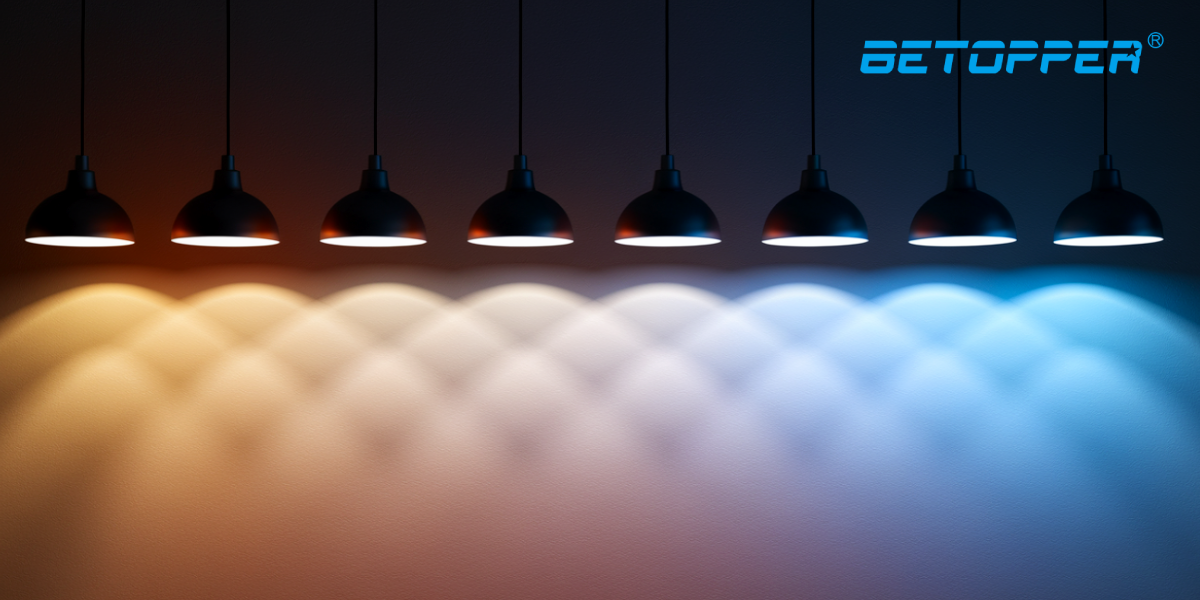Choisir un éclairage de scène ne se résume pas à choisir des luminaires : il s'agit de trouver le juste équilibre entre fonctionnalité, créativité et budget. Que vous organisiez un concert, une production théâtrale ou un événement, des choix d'éclairage judicieux peuvent créer une ambiance, mettre en valeur les moments clés et garantir une performance technique impeccable.
Dans ce guide, nous aborderons les conseils essentiels pour sélectionner des éclairages de scène adaptés à votre lieu spécifique, à vos objectifs de conception et à vos exigences pratiques.
Comprendre le rôle de l'éclairage de scène
Éclairage de scène L'éclairage ne se limite pas à éclairer la performance. Il guide la concentration, crée une atmosphère et met en valeur les éléments essentiels d'une performance. Par exemple, un projecteur éclaire un soliste ou des gélatines colorées qui suscitent des sentiments de passion (rouge) ou de tranquillité (bleu) lorsqu'elles sont projetées sur le public. Ces rôles vous permettent de prioriser les caractéristiques lors du choix de votre équipement d'éclairage.
Types d'éclairage de scène
Comprendre les différents types d'éclairage de scène est essentiel lors de la planification d'un éclairage professionnel. Chaque type d'éclairage a une fonction unique et joue un rôle spécifique pour créer l'ambiance, mettre en valeur les artistes et façonner l'expérience visuelle du public.
1. Projecteurs
Pleins feux Conçus pour focaliser des faisceaux lumineux intenses sur une zone ou un sujet spécifique, ils sont couramment utilisés pour mettre en valeur les artistes principaux ou les moments clés de la scène, offrant un contrôle précis de la taille et de l'intensité du faisceau.
De nombreux projecteurs sont dotés d'une mise au point et d'obturateurs réglables, ce qui les rend polyvalents et s'adaptent à différentes configurations scéniques. Au théâtre ou en concert, ils sont souvent actionnés manuellement pour suivre les artistes en mouvement.
2. Lumières de Fresnel
Les projecteurs Fresnel sont dotés d'une lentille distinctive produisant un faisceau diffus aux contours doux, ce qui les rend idéaux pour l'éclairage général de scène. Ils se fondent parfaitement avec d'autres éclairages et créent des transitions naturelles entre ombres et lumière.
La largeur du faisceau de ces projecteurs est réglable en rapprochant ou en éloignant la lampe et le réflecteur de la lentille. Grâce à leur couverture uniforme, ils sont fréquemment utilisés pour éclairer de grandes surfaces ou des arrière-plans.
3. Canettes PAR
Réflecteur parabolique aluminisé Les projecteurs PAR sont un incontournable de l'éclairage scénique grâce à leur durabilité, leur prix abordable et leur simplicité. Ils produisent un faisceau intense et non réglable, idéal pour les jeux de couleurs ou les effets lumineux audacieux.

Image:
Les projecteurs PAR sont couramment utilisés lors de concerts et de tournées, où une installation rapide et des performances robustes sont essentielles. La forme de leur faisceau dépend du type de lampe et de réflecteur utilisés, offrant différents effets pour différents besoins.
4. Projecteurs à tête mobile
Projecteurs à tête mobile Ce sont des projecteurs hautement dynamiques, capables de pivoter et d'incliner pour créer des effets lumineux spectaculaires sur la scène. Ces éclairages intelligents intègrent souvent des fonctions de mélange de couleurs, de motifs de gobos et de mise en forme du faisceau.

Image:
Ils sont largement utilisés lors de concerts, de spectacles et d'événements nécessitant des effets lumineux percutants synchronisés avec la musique ou les signaux de performance. Leur programmabilité et leur polyvalence en font un choix privilégié des concepteurs lumière.
5. Lumières LED
éclairage de scène à LED Les LED sont de plus en plus populaires pour leur efficacité énergétique, leur longue durée de vie et leur polyvalence de couleurs. Disponibles dans de nombreux formats (panneaux LED, rubans et PAR), elles offrent un excellent mélange de couleurs sans gel.
Elles produisent une chaleur minimale, ce qui les rend plus sûres et plus confortables pour les artistes. Les LED sont idéales pour les salles de spectacle recherchant des solutions respectueuses de l'environnement sans sacrifier la performance ni la qualité.
Facteurs à prendre en compte lors du choix des éclairages de scène
Choisir le bon éclairage de scène ne se limite pas au choix d'un appareil : il nécessite une évaluation minutieuse de votre salle, de votre style de spectacle et de vos besoins techniques. Une installation d'éclairage adaptée doit améliorer l'expérience du public, soutenir les artistes et s'adapter aux exigences pratiques de l'espace.
1. Taille et disposition du lieu
Les dimensions et la structure de votre salle influencent considérablement le type et le nombre d'éclairages nécessaires. Une petite scène peut se contenter de quelques projecteurs bien placés, tandis qu'une grande salle de concert exige une installation plus complexe et un rendement plus élevé.
La hauteur du plafond, la profondeur de la scène et la disposition des sièges influencent la diffusion de la lumière et la couverture nécessaire. Il est important de toujours réfléchir à un éclairage uniforme de l'ensemble de la scène, sans gaspillage d'énergie ni création d'ombres indésirables.
2. Type de performance
Chaque représentation requiert une approche lumineuse différente. Une pièce de théâtre bénéficiera de tons subtils et chaleureux et de projecteurs précis, tandis qu'un concert de rock nécessitera des couleurs vives et des projecteurs mobiles pour des effets dynamiques.
Les spectacles de danse nécessitent souvent un mélange de lumières de lavage et un éclairage latéral pour mettre en valeur le mouvement. Comprendre la nature de votre spectacle garantit que l'éclairage s'harmonise avec l'atmosphère et la narration.
3. Compatibilité du système de contrôle
L'éclairage de scène moderne repose souvent sur des systèmes de contrôle numérique tels que DMX512 Pour la programmation et la synchronisation, il est essentiel de s'assurer que vos éclairages sont compatibles avec vos équipements de contrôle existants ou prévus.
Déterminez si vous avez besoin d'appareils compatibles avec le contrôle à distance, l'automatisation ou l'intégration avec des systèmes audio et vidéo. Une configuration de contrôle bien intégrée permet une plus grande créativité et une plus grande précision lors des performances live.
4. Besoins en énergie et production de chaleur
L'éclairage de scène peut être gourmand en énergie ; il est donc important de vérifier que le système électrique de votre salle peut supporter la charge. Les éclairages LED sont souvent privilégiés pour leur faible consommation d'énergie et leur faible dégagement de chaleur.
Les luminaires traditionnels, comme les lampes halogènes ou à arc, peuvent produire un flux lumineux puissant, mais aussi générer une chaleur importante, susceptible de compromettre le confort des artistes et la sécurité sur scène. Il est donc essentiel de trouver le juste équilibre entre les besoins en luminosité, l'efficacité et la sécurité opérationnelle.
5. Contraintes budgétaires
Votre budget influencera inévitablement vos choix d'éclairage, du type de luminaires au nombre d'unités que vous pouvez installer. Si les éclairages haut de gamme offrent des fonctionnalités avancées, de nombreuses options abordables offrent des performances solides pour les productions de plus petite envergure.
Il est souvent plus judicieux d'investir dans des luminaires polyvalents et de qualité, polyvalents, plutôt que de dépenser des sommes excessives pour du matériel spécialisé. N'oubliez pas de prendre en compte les accessoires, le câblage et les coûts de maintenance dans votre planification.
6. Portabilité et installation
Si votre installation d'éclairage doit être mobile, par exemple pour des tournées ou des événements multisites, le poids, la facilité de montage et la durabilité sont essentiels. Des luminaires légers, robustes et rapides à monter permettent de gagner du temps et de soulager votre équipe.
En revanche, les installations fixes dans les théâtres ou les salles de spectacles peuvent privilégier des solutions d'éclairage intégrées et plus permanentes. Tenez compte de la flexibilité et de la praticité à long terme de votre matériel d'éclairage en fonction de votre style de production.
Budgétisation de l'éclairage de scène
Le budget est un élément essentiel de tout plan d'éclairage scénique, car il détermine les équipements et les fonctionnalités réalisables. Évaluer soigneusement vos options peut vous aider à optimiser votre investissement tout en garantissant l'impact visuel requis par votre production.
Location ou achat
Décider entre location et achat d'éclairages de scène cela dépend de la fréquence et de l'ampleur de vos productions.
- La location est idéale pour les événements ponctuels ou les besoins à court terme, offrant un accès à du matériel haut de gamme sans coût initial important.
- L’achat, en revanche, est plus rentable à long terme pour les lieux ou les entreprises ayant des besoins d’éclairage réguliers.
La propriété vous donne également un meilleur contrôle sur votre configuration et une personnalisation à long terme.
Appareils haut de gamme vs modèles économiques
Les luminaires haut de gamme sont souvent dotés de fonctionnalités avancées, d’une meilleure qualité de fabrication et de performances supérieures, mais ils ont également un prix plus élevé. Les modèles économiques peuvent manquer de flexibilité ou de précision, mais peuvent néanmoins répondre aux besoins de spectacles plus petits ou moins complexes.
L'essentiel est d'adapter les capacités de l'équipement aux besoins réels de vos productions. Parfois, combiner quelques unités haut de gamme avec des éclairages basiques peut offrir une solution équilibrée et économique.
Coût initial vs dépenses courantes
Lors de l'établissement d'un budget, il est important de ne pas se limiter à l'achat initial ou au loyer. Tenez compte des coûts récurrents comme l'entretien, les pièces de rechange, la consommation d'énergie et l'assistance technique.
Par exemple, les luminaires LED peuvent coûter plus cher au départ, mais permettent de réaliser des économies à long terme grâce à une consommation d'énergie moindre et une durée de vie plus longue. Un budget réaliste prend en compte le coût total de possession, et pas seulement le prix du luminaire.
FAQ
1. Comment choisir la bonne lumière ?
Choisissez l’éclairage en fonction de la taille de la salle, du type de représentation, des effets visuels souhaités et de la compatibilité avec votre système de contrôle et votre budget.
2. Quel équipement d'éclairage est utilisé pour la scène ?
L'équipement d'éclairage de scène courant comprend des projecteurs, des lumières Fresnel, des projecteurs PAR, des luminaires LED et des projecteurs à tête mobile, souvent soutenus par des consoles de contrôle, des gradateurs et du matériel de montage.
3. Comment disposer les lumières de la scène ?
Les lumières de la scène doivent être disposées de manière à assurer une couverture équilibrée, à mettre en évidence les zones clés de la performance et à améliorer l'ambiance, en utilisant généralement une combinaison d'angles d'éclairage avant, latéraux et arrière.
4. Quelle est la règle de base pour éclairer une scène ?
La règle fondamentale est d'assurer la visibilité tout en soutenant l'ambiance et la concentration de la performance, en utilisant l'éclairage pour guider l'attention du public sans surcharger la scène.




Laisser un commentaire
Tous les commentaires sont modérés avant d'être publiés.
Ce site est protégé par hCaptcha, et la Politique de confidentialité et les Conditions de service de hCaptcha s’appliquent.